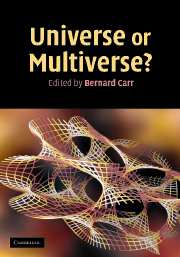Book contents
- Frontmatter
- Contents
- List of contributors
- Preface
- Acknowledgements
- Editorial note
- Part I Overviews
- Part II Cosmology and astrophysics
- Part III Particle physics and quantum theory
- 14 Quarks, electrons and atoms in closely related universes
- 15 The fine-tuning problems of particle physics and anthropic mechanisms
- 16 The anthropic landscape of string theory
- 17 Cosmology and the many worlds interpretation of quantum mechanics
- 18 Anthropic reasoning and quantum cosmology
- 19 Micro-anthropic principle for quantum theory
- Part IV More general philosophical issues
- Index
- References
16 - The anthropic landscape of string theory
Published online by Cambridge University Press: 05 July 2014
- Frontmatter
- Contents
- List of contributors
- Preface
- Acknowledgements
- Editorial note
- Part I Overviews
- Part II Cosmology and astrophysics
- Part III Particle physics and quantum theory
- 14 Quarks, electrons and atoms in closely related universes
- 15 The fine-tuning problems of particle physics and anthropic mechanisms
- 16 The anthropic landscape of string theory
- 17 Cosmology and the many worlds interpretation of quantum mechanics
- 18 Anthropic reasoning and quantum cosmology
- 19 Micro-anthropic principle for quantum theory
- Part IV More general philosophical issues
- Index
- References
Summary
The landscape
The world-view shared by most physicists is that the laws of nature are uniquely described by some special action principle that completely determines the vacuum, the spectrum of elementary particles, the forces and the symmetries. Experience with quantum electrodynamics and quantum chromodynamics suggests a world with a small number of parameters and a unique ground state. For the most part, string theorists bought into this paradigm. At first, it was hoped that string theory would be unique and explain the various parameters that quantum field theory left unexplained. When this turned out to be false, the belief developed that there were exactly five string theories with names like ‘type 2a’ and ‘heterotic’. This also turned out to be wrong. Instead, a continuum of theories were discovered that smoothly interpolated between the five and also included a theory called ‘M-theory’. The language changed a little. One no longer spoke of different theories, but rather of different solutions of some master theory.
The space of these solutions is called the ‘moduli space of supersymmetric vacua’. I will call it the ‘supermoduli-space’. Moving around on this supermoduli-space is accomplished by varying certain dynamical ‘moduli’. Examples of moduli are the size and shape parameters of the compact internal space that 4-dimensional string theory always needs. These moduli are not parameters in the theory, but are more like fields. As you move around in ordinary space, the moduli can vary and have their own equations of motion.
- Type
- Chapter
- Information
- Universe or Multiverse? , pp. 247 - 266Publisher: Cambridge University PressPrint publication year: 2007
References
- 55
- Cited by



